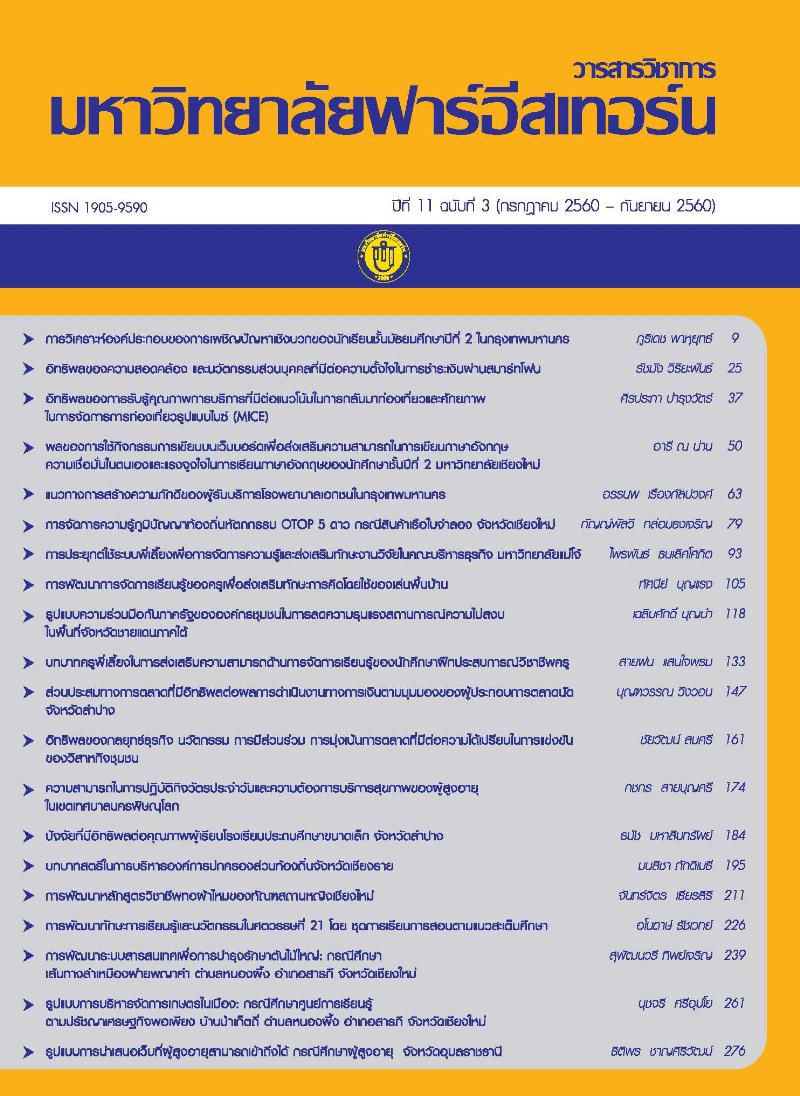รูปแบบการนำเสนอเว็บที่ผู้สูงอายุสามารถเข้าถึงได้ กรณีศึกษาผู้สูงอายุจังหวัดอุบลราชธานี
Main Article Content
Abstract
การวิจยั ครงั้ นี้ มวี ตั ถุประสงคเ์ พอื่ ศึกษารูปแบบเว็บทผี่ สู้ งู อายุสามารถเขา้ ถึงได การวิจยั แบง่ ออกเปน็
4 ขนั้ ตอน คอื 1) กาํ หนดความตอ้ งการ โดยใชแ้ บบสอบถามกับผูส้ งู อายุ 374 คน 2) วเิ คราะหห์ าความตอ้ งการ
รูปแบบการนำเสนอเว็บที่ผู้สูงอายุสามารถเข้าถึงได้ โดยใช้แบบบันทึกความต้องการจากกลุ่มตัวอย่าง 3 คน
3) ออกแบบและพัฒนา และ 4) ประเมิน โดยนำเว็บไปทดลองใช้กับผู้สูงอายุจำนวน 24 คน วิเคราะห์ข้อมูล
โดยใช้ค่าแจกแจงความถี่ ค่าร้อยละ ค่าเฉลี่ย ส่วนเบี่ยงเบนมาตรฐาน ผลการศึกษาสรุปได้ดังนี้
ความตอ้ งการรูปแบบการนำเสนอเว็บของผูส้ งู อายุ พบวา่ รปู แบบการนำเสนอเว็บทมี่ คี า่ เฉลยี่ สูงสุด
5 ลำดับแรก ดังนี้ 1) เม้าส์เข้าถึงข้อมูลโดยการคลิกเม้าส์เพียงครั้งเดียว 2) เมนู อยู่ตำแหน่งที่มองเห็นได้
ชดั เจนในตำแหนง่ เดียวกันทุกหนา้ มีเมนูหรือปุม่ ปรับขนาดตัวอักษรทมี่ องเห็นและเลือกใชไ้ ดง้ า่ ยใชส้ ญั ลักษณ์
ที่สื่อความหมายชัดเจนและเป็นสากล 3) รูปแบบการนำเสนอข้อมูลใช้ภาษาที่ง่าย ชัดเจน เข้าใจได้แบ่งข้อมูล
ที่นำเสนอเป็นส่วนๆ และไม่มากเกินไปในแต่ละหน้า ลดการใช้คำศัพท์แสลงหรือศัพท์เทคนิค 4) ปุ่มและ
ไอคอน เป็นมาตรฐาน สื่อความหมายชัดเจน อยู่ในตำแหน่งที่ง่ายต่อการใช้ มองเห็นได้ง่าย สีของปุ่มและ
ไอคอนแตกต่างจากสีพื้นหลัง 5) การค้นหาตำแหน่งการค้นหาอยู่ในตำแหน่งเดียวกันทุกหน้า
การพัฒนาเว็บที่ผู้สูงอายุสามารถเข้าถึงได้ พบว่า ประกอบด้วยรายละเอียดสำหรับการออกแบบ
และพัฒนา 2 ส่วน ดังนี้ 1) โครงสร้างเว็บและการเข้าถึงเว็บ และ 2) การนำเสนอเนื้อหา
รูปแบบเว็บที่ผู้สูงอายุสามารถเข้าถึงได้ ประกอบด้วยรายละเอียดสำหรับการออกแบบและพัฒนา
ดงั นี้ 1) ชอื่ เว็บใหว้ างอยูส่ ว่ นบนสุดของหนา้ เว็บ เมนูอยูซ่ า้ ยมือของหนา้ เว็บ และเนอื้ หาอยูต่ รงกลางของหนา้ เว็บ
2)ตัวอักษรเป็นชนิด Sans Serif font 3) ระยะห่างของตัวอักษรเป็นแบบปกติ 4) รูปแบบของตัวอักษรเป็น
แบบปกติ 5) พื้นหลังเว็บเป็นสีพื้น 6) หน้าเว็บเลื่อนได้ทั้งแนวตั้งและแนวนอน 7) ตำแหน่งการค้นหาในหน้า
เว็บอยู่ในตำแหน่งเดียวกับส่วนที่เป็นแถบเมนู
การพัฒนาเว็บทผี่ สู้ งู อายุสามารถเขา้ ถึงได ้ ประกอบดว้ ย 3 องคป์ ระกอบ คอื 1) ความสามารถในการรับรู้
2) ความสามารถในการใช้งาน และ 3) ความสามารถในการเข้าใจ
This objective of this research is to investigate web accessibility for elderly. The research
consisted of 4 stages: 1) The 374 respondents were asked for their requirement by using questionnaire.
2) There were 3 sample respondents using requirement assessment form to analyze users’ requirement
on web accessibility for elderly. 3) Design and Development and 4)The trail of web simulation was
collected from 24-elderly. The data was analyzed by using frequency, percentage, mean and
standard deviation. The study revealed that:
The top five of elderly requirements for web accessibility are including: 1) Mouse: able to
access to the information in one click; 2) Menu:ease to use with standard graphical symbols and
located at the same position on every page; 3)Data presentation: Use plain language that was easy
to read and understand without slang or technical term and good portion of information on each
page; 4) Icons and buttons: used standard symbols, located at outward position with background
color contrast; 5) Searching menu: located at the same position of every page.
The development ofweb accessibility for elderly consists of 2 parts: 1) Web structure and
accessibility, and 2) Content presentation. Web accessibility for elderlyconsistsof important details
as follows: 1) The page title should be on top, menu was on the left, and the content was at the
center of the page; 2) Style of a typeface should be Sans Serif Font; 3) Spacing between character
should be normal; 4) Font type should be normal; 5) Light color background; 6) The page should
be able to scroll vertically and horizontally; 7) Searching icon should be in the same area of menu.
Development of web accessibility for Thai elderly were: 1) Perceivable 2) Operable
3) Understandable.
Article Details
1. Any views and comments in the Journal of Social Innovation and Lifelong Learning are the authors’ views. The editorial staff have not to agree with those views and it is not considered as the editorial’s responsibility.
2. The responsibility of content and draft check of each article belongs to each author. In case, there is any lawsuit about copyright infringement. It is considered as the authors’ sole responsibility.
3. The article copyright belonging to the authors and The Far Eastern University are copyrighted legally. Republication must be received direct permission from the authors and The Far Eastern University in written form.
References
ปรีดี ปลื้มสำราญกิจ. (2554). ความสามารถในการเข้าถึงได้ทางเว็บไซต์. วารสารบรรณาศาสตร์, 4(2), 95-106.
สำนักงานปลัดกระทรวงเทคโนโลยีสารสนเทศและการสื่อสาร. (2553). แนวทางการพัฒนาเว็บที่ทุกคนเข้าถึงได้ TWCAG 2010 (Thai Web Content Accessibility Guidelines 2010). กรุงเทพฯ: สำนักส่งเสริมและพัฒนาการใช้เทคโนโลยีสารสนเทศการสื่อสาร.
สำนักงานสถิติแห่งชาติ. (2559). สำรวจการมีการใช้เทคโนโลยีสารสนเทศและการสื่อสารในครัวเรือน พ.ศ. 2559. กรุงเทพฯ: กระทรวงเทคโนโลยีสารสนเทศและการสื่อสาร.
สำนักนโยบายและส่งเสริมธุรกรรมทางอิเล็กทรอนิกส์. (2559). รายงานผลการสำรวจพฤติกรรมผู้ใช้อินเทอร์เน็ตในประเทศไทย ปี 2559. กรุงเทพฯ: กระทรวงเทคโนโลยีสารสนเทศและการสื่อสาร.
Chadwick-Dias, A., McNulty, M., and Tullis, T. (2003). Web Usability and Age: How Design Changes can Improve Performance. Proceedings of the 2003 Conference on Universal Usability. (pp. 30-37). Canada: ACM SIGCAPH Computers and Physically Handicapped.
Darvishy, A. and Good, A. (2013). Inclusive websites for the elderly: user friendly guideline for designers and managers of websites and applications. In HCI International 2013, 21-25.
Hart, T.A., Chaparo, B.S and Halcomb, C.G. (2008). Evaluating website for older adults: adherence to ‘senior-friendly’ guideline and end-user performance. Behaviour & Information Technology, 27(3), 191-199.
Hawthorn, D. (2003). How universal is good design for older users?. Proceedings of the 2003 Conference on Universal Usability. (pp. 38-45). Canada: ACM SIGCAPH Computers and Physically Handicapped.
Holt, B. (2000). Creating Senior-Friendly Web Sites. Center for medicare education, 1(4), 1-8.
Hole, B.J., and Komlos-Weimer, M. (1999). Order Adults and the World Wide Web: SSPRY Foundation. Retrieved December 18, 2013, from http://www.spry.org/pdf/websitecreatorsguide.pdf.
Johnson, R., and Kent, S. (2007). Designing universal access: web-applications for the elderly and disabled. Cogn Tech Work, 9, 209-218.
Kurniawan, S., Zaphiris, P. (2005). Research-Derived Web Design Guidelines for Older People. Proceedings of the 7th international ACM SIGACCESS conference on Computers and Accessibility. (pp. 129-135). United States of America: ACM New York.
Lee, B., Chen, Y., and Hewitt, L. (2011). Age differences in constraints encountered by seniors in their use of computers and the internet. Computers in Human Behavior, 27, 1231-1237.
National Institute on Aging. (2009). Making Your Website Senior Friendly Tips from the National Institute on Aging and the National Library of Medicine. Retrieved December 20, 2013, from http://www.nlm.nih.gov/pubs/checklist.pdf
World Wide Web Consortium (W3C). (2012). Web Content Accessibility Guidelines (WCAG). Retrieved December 18, 2013, from http://www.w3.org/WAI/intro/wcag
Zaphiris, P., Kurniawan, S., and Ghiawadwala, M. (2007). A systematic approach to the development of research-based web design guidelines for older people. Universal Access in the Information Society Journal, 6(1), 59-75.

